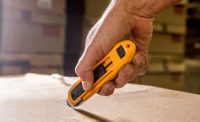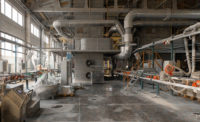The United States is at its lowest unemployment rate since 19691, more organizations than ever are hiring. The turnover rate is increasing as organizations raise their wages to compete for talent. This results in a greater need for consistent safety training and makes maintaining a safe work environment even more challenging. However, with proper safety training, the implementation of safety measures and the usage of safety products (such as safety knives) you can create a safe work environment2 while reducing claim liabilities.
In many workplaces, utility knives are some of the most used tools throughout the day, but what makes them so important? According to the Bureau of Labor Statistics (BLS)3, in 2016 there were a total of 91,340 injuries associated with cuts, lacerations and punctures. These injuries not only decrease employee productivity but also result in an average claim cost of over $6,0004.
Choosing the appropriate safety knife for your company is an important decision that directly impacts your employees’ safety and your company’s brand. Many factors need to be discussed and assessed.
Questions to ask
- What are you cutting with your knife?
- How frequently is your team using the knife?
- Do you feel comfortable having your employees handle and properly dispose of loose razor blades?
- How much is your organization currently spending on laceration claims that could be avoided by using a safer knife?
Protection
There are many utility knives to choose from; your safety and protection goals will determine which choice best suites your company’s needs. Accidental injuries happen when the employee least expects it. Therefore, the best and most proactive approach is to eliminate possible causes of such injuries at the tool level, supplemented by proper training. Safety utility knives offer a variety of safety features such as a full blade guard that covers the blade and will lock to protect the user after each cut. Others have retractable blades which are only exposed when the knife is engaged. Also keep in mind that if your knife is used on or around food items it may need to be NSF Certified and/or made with FDA-compliant materials.
Blades
The replaceable blade is an extremely popular option due to its cost effectiveness but offers negligible safety benefits. Loose blades, if not properly cared for, can be found in warehouses, retail centers and restaurants but perhaps there is no more dangerous place than contamination of the food stream. Conversely, safety utility knives with embedded blades have a proven track record of minimizing contamination and reducing laceration claims, directly boosting bottom-line revenue. Embedded blade knives are available in two formats, a fully disposable version and a more environmentally friendly cartridge version.
Maintaining balance between a healthy budget and ensuring a safe workplace continues to be a major challenge many managers face in their respective industries. But when assessing the net gain as a result of reducing injury claims and protecting the brand, the upfront investment in safety knives has proven to be worthwhile.
CrewSafe®, division of Spellbound Development Group, Inc., provides innovative solutions to solve safety and brand protection challenges to the world’s largest industrial, retail, food service organizations. www.crewsafe.com
Sources:







